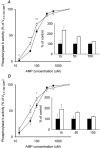Contraction-mediated glycogenolysis in mouse skeletal muscle lacking creatine kinase: the role of phosphorylase b activation
- PMID: 12963789
- PMCID: PMC2343558
- DOI: 10.1113/jphysiol.2003.051078
Contraction-mediated glycogenolysis in mouse skeletal muscle lacking creatine kinase: the role of phosphorylase b activation
Abstract
Skeletal muscle that is deficient in creatine kinase (CK-/-) exhibits accelerated glycogenolysis during contraction. Understanding this phenomenon could provide insight into the control of glycogenolysis during contraction. Therefore, glycogen breakdown was investigated in isolated extensor digitorum longus CK-/- muscle. Muscles were stimulated to produce repeated tetani for 20 s in the presence of sodium cyanide to block mitochondrial respiration. Accumulation of lactate after stimulation was similar in wild-type (WT) and CK-/- muscles, whereas accumulation of glucose-6-phosphate was twofold higher in CK-/- muscles, indicating greater glycogenolysis in CK-/- muscles. Total phosphorylase activity was decreased by almost 30 % in CK-/- muscle (P < 0.001). Phosphorylase fractional activity (-/+ 3.3 mM AMP) was similar in both groups in the basal state (about 10 %), but increased to a smaller extent in CK-/- muscles after stimulation (39 +/- 4 % vs. 52 +/- 4 % in WT, P < 0.05). Inorganic phosphate, the substrate for phosphorylase, increased marginally in CK-/- muscles after stimulation (basal = 25.3 +/- 2.2 micromol (g dry muscle)-1; stimulated = 33.9 +/- 2.3 micromol (g dry muscle)-1), but substantially in WT muscles (basal = 11.4 +/- 0.7 micromol (g dry muscle)-1; stimulated = 54.2 +/- 4.5 micromol (g dry muscle)-1). Kinetic studies of phosphorylase b (dephosphorylated enzyme) from muscle extracts in vitro demonstrated higher relative activities in CK-/- muscles (60-135 %) in response to low AMP concentrations (up to 50 microM) in both the basal state and after stimulation (P < 0.05), whereas no differences in activity between CK-/- and WT muscles were observed at high AMP concentrations (> 100 microM). These data indicate that allosteric activation of phosphorylase b accounts for the accelerated glycogenolysis in CK-/- muscle during contraction.
Figures



Similar articles
-
Murine muscles deficient in creatine kinase tolerate repeated series of high-intensity contractions.Pflugers Arch. 2001 Nov;443(2):274-9. doi: 10.1007/s004240100687. Pflugers Arch. 2001. PMID: 11713654
-
Effect of acute activation of 5'-AMP-activated protein kinase on glycogen regulation in isolated rat skeletal muscle.J Appl Physiol (1985). 2007 Mar;102(3):1007-13. doi: 10.1152/japplphysiol.01034.2006. Epub 2006 Nov 22. J Appl Physiol (1985). 2007. PMID: 17122373
-
Influence of reduced glycogen level on glycogenolysis during short-term stimulation in man.Acta Physiol Scand. 1990 Jul;139(3):467-74. doi: 10.1111/j.1748-1716.1990.tb08948.x. Acta Physiol Scand. 1990. PMID: 2239350
-
Effects in skeletal muscle.Adv Pharmacol. 2005;52:209-28. doi: 10.1016/S1054-3589(05)52011-8. Adv Pharmacol. 2005. PMID: 16492548 Review.
-
Regulation of glycogen breakdown and its consequences for skeletal muscle function after training.Mamm Genome. 2014 Oct;25(9-10):464-72. doi: 10.1007/s00335-014-9519-x. Epub 2014 Apr 29. Mamm Genome. 2014. PMID: 24777203 Review.
Cited by
-
Isoproterenol enhances force production in mouse glycolytic and oxidative muscle via separate mechanisms.Pflugers Arch. 2019 Oct;471(10):1305-1316. doi: 10.1007/s00424-019-02304-0. Epub 2019 Aug 21. Pflugers Arch. 2019. PMID: 31451903 Free PMC article.
-
Rearrangement of energetic and substrate utilization networks compensate for chronic myocardial creatine kinase deficiency.J Physiol. 2011 Nov 1;589(Pt 21):5193-211. doi: 10.1113/jphysiol.2011.212829. Epub 2011 Aug 30. J Physiol. 2011. PMID: 21878522 Free PMC article.
-
A century of exercise physiology: key concepts in regulation of glycogen metabolism in skeletal muscle.Eur J Appl Physiol. 2022 Aug;122(8):1751-1772. doi: 10.1007/s00421-022-04935-1. Epub 2022 Mar 30. Eur J Appl Physiol. 2022. PMID: 35355125 Free PMC article. Review.
-
Defects in Galactose Metabolism and Glycoconjugate Biosynthesis in a UDP-Glucose Pyrophosphorylase-Deficient Cell Line Are Reversed by Adding Galactose to the Growth Medium.Int J Mol Sci. 2020 Mar 16;21(6):2028. doi: 10.3390/ijms21062028. Int J Mol Sci. 2020. PMID: 32188137 Free PMC article.
-
Raptor ablation in skeletal muscle decreases Cav1.1 expression and affects the function of the excitation-contraction coupling supramolecular complex.Biochem J. 2015 Feb 15;466(1):123-35. doi: 10.1042/BJ20140935. Biochem J. 2015. PMID: 25431931 Free PMC article.
References
-
- Aragon JJ, Tornheim K, Lowenstein JM. On a possible role of IMP in the regulation of phosphorylase activity in skeletal muscle. FEBS Lett. 1980;117:K56–64. - PubMed
-
- Broberg S, Katz A, Sahlin K. Propranolol enhances adenine nucleotide degradation in human muscle during exercise. J Appl Physiol. 1988;65:2478–2483. - PubMed
-
- Brostrom CO, Hunkeler FL, Krebs EG. The relation of skeletal muscle phosphorylase kinase by Ca2+ J Biol Chem. 1971;246:1961–1967. - PubMed
-
- Brown DH, Cori CF. Animal and plant polysaccharide phosphorylase. In: Boyer LM, editor. The Enzymes. Vol. 5. New York: Academic; 1961. pp. 207–228.
Publication types
MeSH terms
Substances
LinkOut - more resources
Full Text Sources
Molecular Biology Databases
Research Materials

